Feel free to watch this video on YouTube with timestamps in the description for ease of navigation. If you prefer to read how to use the Enlite Routes App, please continue with the article below.
The Enlite Routes app is designed to assist your drivers with their routes, deliveries, and pickups. It provides turn-by-turn navigation, the ability to take pictures to document deliveries and the ability to scan invoices at the time of loading the truck or making a delivery. This guide will walk you through using the application to run a route with the different functionality the app offers.
- Logging In
When you open the Enlite Routes app, you will be presented with the login screen (Pic 1.1). It is important that your drivers have the Driver role in the store Enlite application (Pic 1.2). Also, the route must be assigned to that Driver, for it to be visible to him or her (Pic 1.3), unless you are using a setting to override this, more information on this in Step 9. All roles may be assigned routes and access the Enlite Routes app. However, they must use the (Login) version of the role. For example, for an Employee to use the Enlite Routes app, he or she must have the Employee (Login) role, as opposed to the regular Employee Please see the article for the Employees module for a deeper explanation on roles.
Pic 1.1
Pic 1.2

Pic 1.3

2. Route List
After logging into the application, you will see the list of your routes (Pic 2.1). This can be set, to only show the routes that should be run on the current day. So, for example, on Monday, will only show the routes that run on Monday. More information on the app settings later in this guide. In this example, we will be running the North Side, so we tap that route to enter it.
Pic 2.1

3. Route Information
Upon entering the route you will be able to see all of the stops on that route as well as the number of invoices pending delivery that each stop has (Pic 3.1). From this screen, several actions can be taken:
-
The Overview button provides a map view of the entire route (Pic 3.2).
-
The Add button (Pic 3.3), allows you to add a One-Time stop to the route. This means that a customer will be added to the route, but next time the route is run again, that customer will not appear as a stop. When the button is pressed, you will see a search screen (Pic 3.4), where you can search for a customer and add them to the route.
-
Tapping on a customer will display the invoices available for delivery (Pic 3.5).
-
While inside customer record, you have the option of sending the customer an email message (3.6).
-
The sort button allows sorting the route stops by various options (Pic 3.7). The Default sort order is the one by which the stops are ordered in the store Enlite application, Routes module. The Manual sort option will allow you to drag and drop the customers into the order you prefer.
-
Finally, pressing the Open button will open the route, to begin working with it, we’ll look at this in the next step.
Pic 3.1
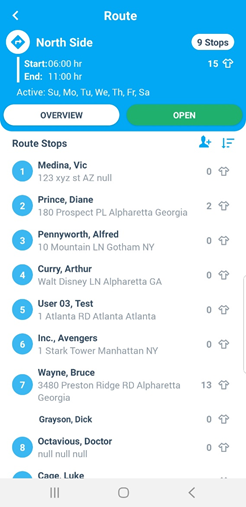
Pic 3.2

Pic 3.3

Pic 3.4
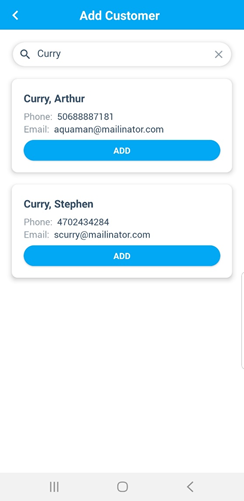
Pic 3.5

Pic 3.6
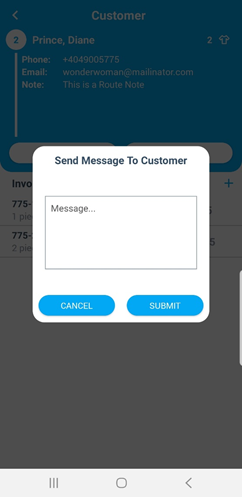
Pic 3.7

4. Opening the Route
Opening the route allows the driver to specify what invoices/orders are going into the truck to be delivered. Once the route is open, you will see the customer list, but this time customers and/or orders must be selected be put in the truck for delivery (Pic 4.1). There are various ways that customers/invoices may be selected for delivery:
-
The Select All button, selects all the customers and their invoices/orders for delivery. When a customer or invoice is selected, the invoice status is changed to Out for Delivery, meaning, the garments are in the truck to be delivered.
-
You can tap the customer record, which will select all orders belonging to that customer, or the customer record can be expanded and invoices can be selected individually (Pic 4.2).
-
Pressing the scan button (Pic 4.3), allows the driver to use his phone’s camera, to scan invoices as he puts them into his truck. Each invoice that is scanned, will be marked as Out for Delivery. This is slower, but provides the most accuracy, as the driver is physically scanning the invoice as it goes into his truck (Pic 4.4 & 4.5).
Finally, when customers/invoices are selected, the Start button will become enabled. This button initiates the route.
Pic 4.1

Pic 4.2

Pic 4.3

Pic 4.4
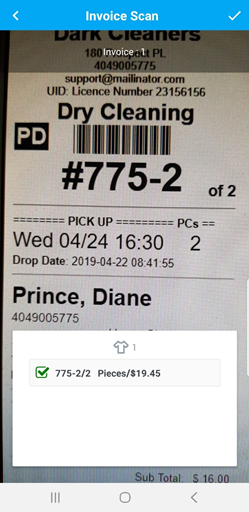
Pic 4.5

5. Route Start
After pressing the Start button you will be presented with a map and your first stop (Pic 5.1). From this screen you can take a few actions:
A. Route – This button will open the Map provider selected in your settings, to provide turn-by-turn navigation to the stop’s address.
B. Next Stop – Tapping the right chevron icon will select the next stop in the route. Please note, that this will navigate through the stops that have invoices/orders that are in the truck for delivery as specified in Step 4 of this guide.
C. Arrived – Pressing the Arrived button will bring up the invoices for that stop. See the next step.
Pic 5.1
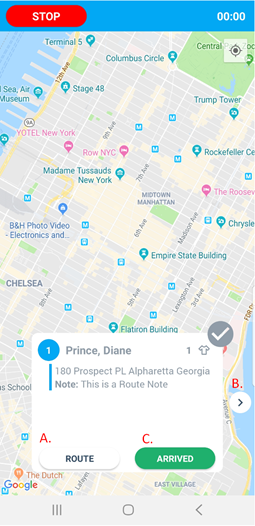
6. Marking Invoices Delivered
When you arrive at the stop’s location and press the Arrive button, you will be presented with a screen to assign a status for each order (Pic 6.1). Several actions can be taken from this screen. You should recognize some of the icons, as they have been present in other screens we have covered.
A. C_ancel_ – This button takes you back to the previous screen without taking any actions on the Stop’s invoices
B. Message – This button was discussed in step 3 and allows sending the customer an email message. See Pic 3.6 for the messaging screen.
C. Invoice Status – Upon reaching this screen, the invoices will have the Out for Delivery status. When the driver delivers them, they will set them to Delivered. If the driver was conducting a pickup, he would retrieve the items and set the invoice to Picked Up. When items are marked Delivered, the status shows it and the invoice receives a green check to show it is completed (Pic 6.2).
D. Scan Invoices – Allows scanning the invoice barcodes with the phone’s camera, to mark them delivered. See Pic 4.4 & 4.5 in this guide to see the screen. This is slower, but beneficial because if the driver scans an invoice that belongs to a different stop, the application will show an error. This reduces the chances that a driver will deliver an order to an incorrect customer.
E. Done – Commits the changes the driver has made to the invoices’ statuses and takes the driver back to the Route start screen showing the next stop on the route.
F. Adding a Pickup – If the driver makes a delivery and the customer receives him with more items to take back for cleaning, the driver is able to create a pickup/order for the items that he or she is receiving. See details on the next step.
Pic 6.1 
Pic 6.2

7. Creating a Pickup
Pressing the Add button from the previous screen, allows you to create a pickup. You can specify the number of items being picked up, the status, and any comments or special instructions from the customer. In pic 7.1, we are picking up 4 items, the status is currently set to Booked and there is a note from the customer specifying creasing their pants. When ready, we hit the Submit button to commit the pickup to the system. In Pic 7.2, we can see the last record is the Pickup, and it now has an invoice number (776-1), you can see the status and the Notes we set. Because this pickup is being created by the driver as he is receiving the clothes, a more appropriate status would Picked Up. But if the driver receives a call from the store to make an additional stop, they can create the pickup under the appropriate customer and leave it with the Booked status until he or she picks up the garments.
When you are finished working with you’re the customer, you press the Done button to return to the route navigation screen.
Pic 7.1
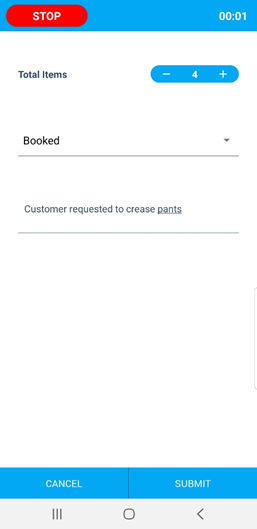
Pic 7.2

8. Finishing the Route
After pressing the Done button for a stop, you will return to the route navigation screen to work with the next stop. We covered this screen on step 5 of this guide, please refer to that step for details. If this were the last stop on the route or the last one we are going to make for today, it’s important to press the Stop button (Pic 8.1). Pressing the Stop button commits all the actions made during the route to the system. It also generates an email that can be sent to specified recipients, with all of the information for the run. It includes the invoices that were picked up/delivered along with the GPS coordinates of where each action was taken. It also includes any pictures the driver took during the route. Again, this is a critical step to conclude the route process as it commits actions to the system and generates a report with everything that happened on the run.
Pic 8.1

9. Enlite Routes App Settings
The Enlite Routes App has several settings that can be adjusted for a better fit with your operation (Pic 9.1). Below is a summary of the settings and their function:
A. Map Provider – The map provider is the software that will provide turn-by-turn navigation. Currently, the Routes app supports Google Maps, Waze and Apple Maps. Each has its advantages and disadvantages, but the app lets you select the one you are most comfortable with.
B. 24 Hour Clock – Toggle this on or off depending on whether you would prefer to see the time in 24 hour vs 12 hour (AM/PM) format.
C. Use Coordinates for Direction – The Enlite Store Application allows entering GPS coordinates instead of addresses for customer locations. This is favorable in countries/regions where addresses are less precise. With this setting on, the Routes App will look for those coordinates instead of the customer’s address.
D. Show All Route – Shows all the routes on the Route Selection screen (Pic 2.1), regardless of whether they are assigned to that Driver or not.
E. Hide Stops Without Invoices – Hides any stop that has no invoices available for delivery.
F. Show Routes For Today – On the Routes Selection screen (Pic 2.1), shows only the routes that are scheduled to be run the current day.
G. Only Invoices Due Today – Shows only the invoices that have a due date of the current day, or in the past. In other words, will not show invoices with a due date in the future as those would not be ready to be delivered.
H. Group Child Accounts – Groups child accounts under the Master Account. For example, if you are delivering to 30 officers at a police station, it will only show the Master Account or the Police Department in the stop list, instead of the 30 different officers. All of their individual invoices will still show up but will appear under the Police Department account, as opposed to individually under each of the 30 officers.
I. Charge When Invoice Marked Delivered – When the invoices are marked delivered, the customer will automatically be charged for the service. This requires the Enlite Store app to be integrated with a Payment Processor and that the customer has a credit card in the system. If you need assistance or information regarding payment processors please contact [email protected].
J. Driver En Route – Automatically sends a text message to the customer when the driver is in route to the customer’s location.
K. Order Picked Up – Automatically sends a text message to the customer when the driver marks an invoice/order Picked Up (Pic 6.1).
L. Order Delivered – Automatically sends a text message to the customer when the driver marks an invoice/order Delivered (Pic 6.1).
Pic 9.1
